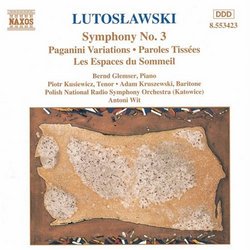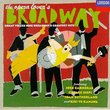| All Artists: Adam Kruszewski, Witold Lutoslawski, Antoni Wit, Polish Radio Orchestra & Chorus Katowice, Katowice Radio Symphony Orchestra, Bernd Glemser, Piotr Kusiewicz Title: Lutoslawski: Symphony No. 3; Paganini Variations; Paroles Tissées; Les Espaces du Sommeil Members Wishing: 0 Total Copies: 0 Label: Naxos Release Date: 4/22/1997 Genres: Pop, Classical Styles: Vocal Pop, Opera & Classical Vocal, Forms & Genres, Concertos, Historical Periods, Modern, 20th, & 21st Century, Symphonies Number of Discs: 1 SwapaCD Credits: 1 UPC: 730099442329 |
Search - Adam Kruszewski, Witold Lutoslawski, Antoni Wit :: Lutoslawski: Symphony No. 3; Paganini Variations; Paroles Tissées; Les Espaces du Sommeil
 | Adam Kruszewski, Witold Lutoslawski, Antoni Wit Lutoslawski: Symphony No. 3; Paganini Variations; Paroles Tissées; Les Espaces du Sommeil Genres: Pop, Classical
These pieces run the full length of Witold Lutoslawki's career. The Paganini Variations are based on the same theme that both Brahms and Rachmaninoff used in their Paganini variations (so did Boris Blacher and about a m... more » |
Larger Image |
CD DetailsSynopsis
Amazon.com These pieces run the full length of Witold Lutoslawki's career. The Paganini Variations are based on the same theme that both Brahms and Rachmaninoff used in their Paganini variations (so did Boris Blacher and about a million other composers, including Paganini himself--it's a great tune). The Third Symphony was commissioned by the Chicago Symphony Orchestra, and first performed by them under Sir Georg Solti. As with many of the composer's larger works, it falls naturally into two parts, an introduction and a main movement. The essence of the music is simple: nothing happens until the end, when the orchestra at last achieves an unbroken melody. The other two pieces are both song cycles that show the composer's sensitivity in setting words. The performances are very good indeed, and texts with translations are included. --David Hurwitz Similar CDs
|
CD ReviewsOne of the great symphonic works of the century. Karl Henzy | 12/24/1998 (5 out of 5 stars) "The Amazon.Com reviewer is misleading about the 3d Symphony. Nothing much happens until the end, he says. I suppose you could say that, if for you something happening has to mean the old, conventional symphonic gestures. But with Lut. everything happens between these gestures, as if he's noticing everything that the traditional symphony left out. And what he notices and conveys is magic and delight. In fact, the 3d Symphony is probably Lutoslawski's masterpiece (though there are a number of contenders), and certainly one of the greatest symphonies of the century." The best "Third" and sensational Paganini Var. Karl Henzy | 01/09/1999 (5 out of 5 stars) "After listening with great enthusiasm to Salonen's recording of the 3rd (as well as that of the composer conducting), I always skipped that portion of this disc, on the assumption that I already knew the third in excellent performances. What a revelation the Wit performance is. And the Polish RSO has the deepest possible identification with this music. The intensity is almost terrifying but exhilerating. I simply couldn't believe how compelling this reading is. The other performances are equal to most other readings of these pieces and the bargain price makes it a must." Surrealism in music. darragh o'donoghue | 11/29/2001 (5 out of 5 stars) "Few composers have come as close as Lutoslawski to achieving an aural equivalent to the Surrealist universe. In his epic setting of Robert Desnos' 'Les espaces du sommeil' (the spaces of Sleep), he creates a restless, nocturnal world, fraught and fragile with fragments of sound imploding and exploding, like a dreamer stumbling through a nightmare, fearful of what the next footstep will bring; a fluid world of metamorphoses - of the self, of the elusive object of desire, of the environment, of the atmosphere. The delicious song-cycle 'Parole Tissees' (woven words), based on a poem by Jean-Francois Chabrun, is close to Ravel in its playful use of the orchestra to evoke sounds and colour, describing a very Ravelian world of screeching cats, shadows, spells, horses etc. - the representations aren't dully onomatopaeic, but disturbingly suggestive. The second movement, 'Quand le jour au revert les branches du jardin', has a precarious night stillness, a hush of wonder and imminent transformation, the equal of anything by the master. the use of Polish singers to sing French texts is inspired - not only signifying Lutoslawski's outsider status as a Pole working with a foreign language; but in dramatising that estrangement from one's very self that is the experience of these poems and settings.Although the monumental Symphony no.3 has no direct basis in Surrealist literature, it carries over this unsettling world-view from the previous works in its vast and terrifying soundscape, its ringing clash of modes and sounds, its lurching from the grotesque and carnivalesque to the lush and melodic. You emerge from it convinced you've voyaged through another world. The CD begins, incongruously perhaps, with yet another variation on Paganini's over-familiar theme, but the composer's very defamiliarising of this piece, his darkening and reworking and reconfiguring it until it sounds new and strange, is itself Surrealist. Antoni Wit and his Polish National Symphony Orchestra may not agree with what I've just written, but they extract maximum imaginative thought and feeling from these works."
|

 Track Listings (7) - Disc #1
Track Listings (7) - Disc #1


